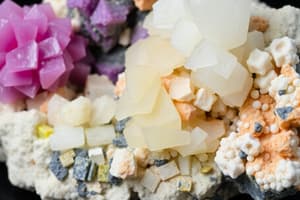Podcast
Questions and Answers
Which subfield of geology studies volcanic activity using specialized instruments?
Which subfield of geology studies volcanic activity using specialized instruments?
- Oceanography
- Geochemistry
- Geobiology
- Geophysics (correct)
What is the primary method geologists use to understand Earth's history?
What is the primary method geologists use to understand Earth's history?
- Analyzing climate patterns
- Studying atmospheric conditions
- Mapping the ocean floor
- Examining the geologic record (correct)
Which of the following best describes geochemistry?
Which of the following best describes geochemistry?
- Analysis of rock samples using chemical methods (correct)
- Measurement of seismic activities
- Research on life in extreme environments
- Study of atmospheric gases
In which area does geobiology primarily focus its study?
In which area does geobiology primarily focus its study?
Which methodology is NOT typically used by geologists to examine rocks?
Which methodology is NOT typically used by geologists to examine rocks?
What percentage of Earth's mass is accounted for by the mantle?
What percentage of Earth's mass is accounted for by the mantle?
Which scientist's hypothesis suggested that Earth's interior is made up of concentric layers with different compositions?
Which scientist's hypothesis suggested that Earth's interior is made up of concentric layers with different compositions?
What characteristic of seismic waves made them useful for exploring Earth's interior?
What characteristic of seismic waves made them useful for exploring Earth's interior?
What evidence did Robert Oldham provide regarding the nature of Earth's core?
What evidence did Robert Oldham provide regarding the nature of Earth's core?
What average density of Earth did Henry Cavendish calculate in 1798?
What average density of Earth did Henry Cavendish calculate in 1798?
Flashcards
Geology
Geology
The study of the Earth's physical structure, its history, and the processes that shape it.
Geophysics
Geophysics
A subfield of geology that uses physics to study Earth's processes.
Geochemistry
Geochemistry
A subfield of geology that studies the chemical composition of rocks and minerals.
Geobiology
Geobiology
Signup and view all the flashcards
Geologic Record
Geologic Record
Signup and view all the flashcards
What is the Earth's crust?
What is the Earth's crust?
Signup and view all the flashcards
What is the Earth's mantle?
What is the Earth's mantle?
Signup and view all the flashcards
What is the Earth's inner core?
What is the Earth's inner core?
Signup and view all the flashcards
What is the Earth's outer core?
What is the Earth's outer core?
Signup and view all the flashcards
What are seismic waves?
What are seismic waves?
Signup and view all the flashcards
Study Notes
Earth's Structure and Density
- Earth's major layers: Crust, Mantle, outer core, and inner core
- Crust (0-40 km): 0.4% of Earth's mass
- Mantle (40-2890 km): 67.1% of Earth's mass
- Outer core (2890-5150 km): 30.8% of Earth's mass
- Inner core (5150-6370 km): 1.7% of Earth's mass
Earth's Density
- Earth's interior layering: different compositions of rock, separated by zones of nearly spherical boundaries
- Density of rocks: rocks vary based on the chemical composition, and their density; for example, rocks with a high proportion of silica (silicon plus oxygen; SiO2) have relatively low densities, below 3 g/cm³.
- Average density of Earth is 5.5 g/cm³ (significantly higher than a typical rock like granite)
- Wiechert's hypothesis: Earth's layered structure is not just due to changes in composition but also to changes in pressure as one descends into the planet's interior.
- Pressure and density: increases with depth
- Density and composition: seismic waves help determine the composition (density and physical state) of different layers.
Studying That Suits You
Use AI to generate personalized quizzes and flashcards to suit your learning preferences.




